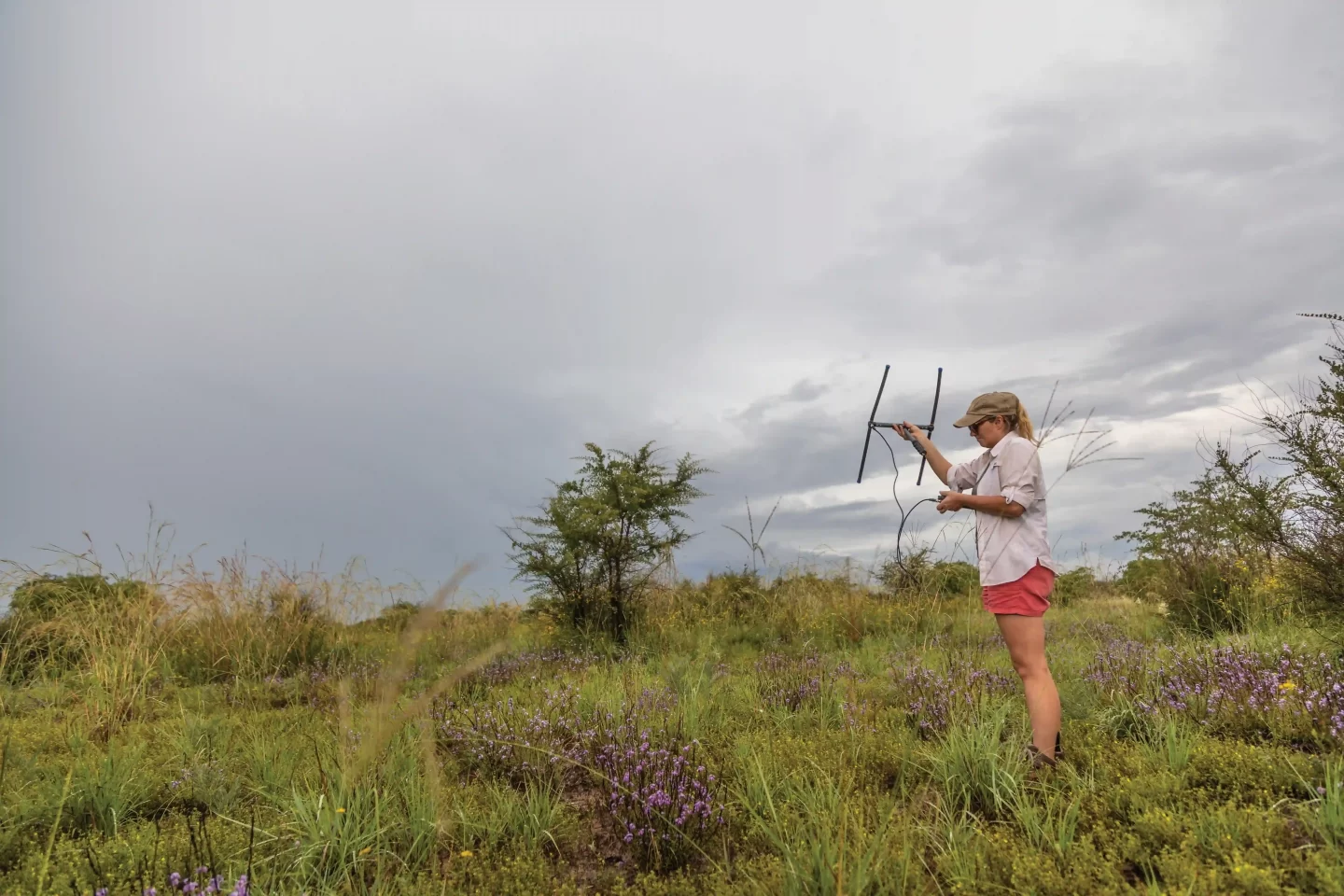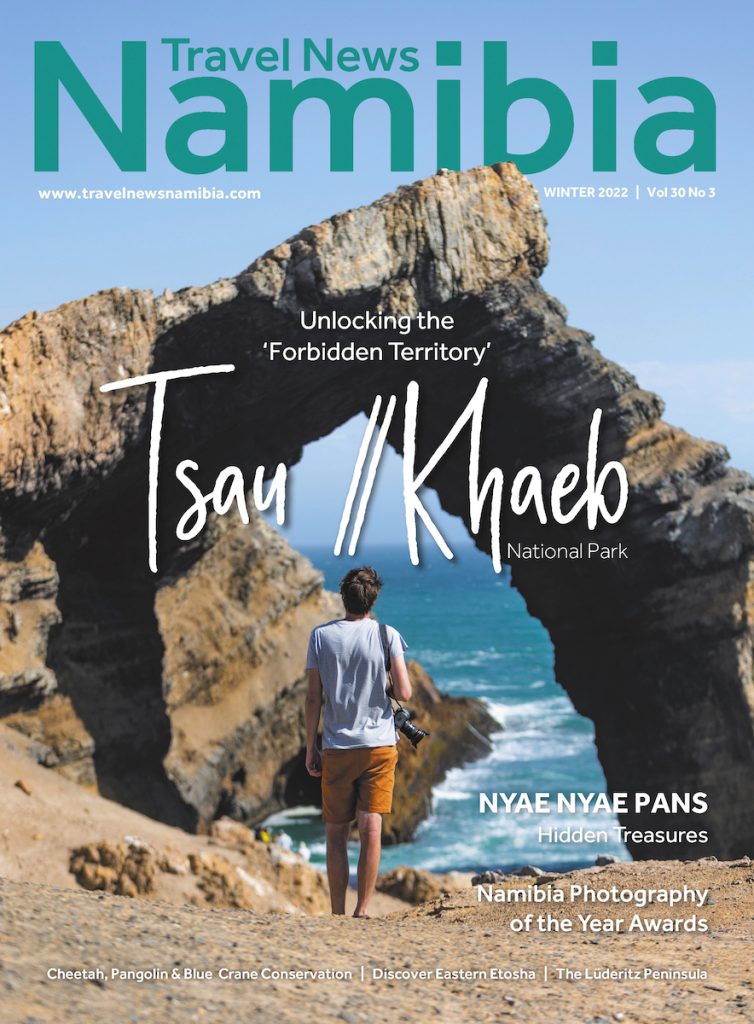

Combining technology and traditional knowledge to save a species
Text & Photographs Le Roux van Schalkwyk
From the Winter 2022 issue
It is ten o’clock on a Friday night and we are sitting in the pitch dark on the wet soil of Bushmanland. The bush is alive with the sound of insects, frogs and even flamingos chattering in the distance from pans, full of water from the recent rains. Overhead, the clouds promise to pour down in another fierce and impressive shower as they have done for the last two days. About five metres away from us a pangolin is cosily holed up in its burrow, oblivious to the fact that some humans eagerly await its appearance. According to the location fixes sent out by the GPS transmitter fixed to one of the pangolin’s scales, it has been using this former warthog burrow as its home for the past couple of weeks. According to the data gathered by the GPS tracker, the pangolin has left its burrow around 21:00 every night in search of food, yet tonight he is a no-show. After an hour or so, with wet bottoms and stiff legs, we head back to camp.
After spending a few days in the field with Kelsey Prediger, patience and perseverance are words that from now on will forever be associated with pangolins. Listening to her various adventures in tracking, tagging and monitoring these scaly creatures, the above rings true time and again. To be honest, after slogging through a wet, sometimes very dense bush, both night and day without seeing one pangolin, I tend to fully agree with Kelsey. It also made me admire her determination to learn more about these vulnerable animals.
Kelsey is the founder and director of the Pangolin Conservation and Research Foundation, the secretariat of the Namibian Pangolin Working Group (chaired by the Ministry of Environment, Forestry and Tourism), and an IUCN pangolin specialist group member and co-chair for southern Africa. In short, she is the go-to person for everything pangolin. Through her research she has committed herself to finding out more about the behaviour and habitats of this shy mammal. The more we know about these animals, the better we can understand key areas specifically related to pangolin conservation, diet, status and release.
Despite being the most trafficked animal in the world, there is surprisingly little known about pangolins. Thousands of pangolins are poached and killed every year. Their scales are used in traditional Chinese medicine, and their meat is a delicacy among some of the wealthy elite in China and Vietnam.
The reason why we joined Kelsey on one of her trips was because of the exciting news that she GPS-tagged the first resident Temminck’s pangolin in a seasonal wetland ecosystem. This was also the first resident pangolin in Namibia tagged with an iridium satellite GPS transmitter. Sadly this was the same pangolin that evaded us. As the transmitters cannot transmit coordinates too deep underground and transmissions happen over timed intervals, the area where the pangolins are is known, but not necessarily where exactly they are.
Interesting data has already been gathered on this particular male pangolin. It has a much larger range than the other pangolins Kelsey has been monitoring in central Namibia. It covered over 60 kilometres in two months, but not in a dispersal pattern – which means the area that it has been utilising can be considered a home range.
The great thing about the data collected is that it allows Kelsey to look closely at the movements and range of this pangolin. This is helpful as the existing data available is for central Namibia, where not only the vegetation is different but there are also game reserves and private land. This is the first data for an area with rural communities as it is part of the Nyae Nyae Conservancy. Invaluable data allows tracking of his movement in relation to people as well as various environmental factors.
Being in a communal area has added an additional and quite exciting aspect to monitoring pangolins. Trackers from the local San community are involved in tracking and monitoring. With their extensive traditional knowledge not only of tracking but also of the area, they can be a valuable asset in learning how the animals use their environment.
Kelsey is in the process of setting up a pangolin ranger initiative similar to the rhino rangers in the northwest, where they protect and monitor black rhinos. San trackers working as pangolin rangers will be able to monitor all aspects of pangolin behaviour, movement and diet while also providing protection for them. If properly trained they can protect the pangolin and other wildlife especially on the boundaries of the conservancy, where poaching is more of a worry, while collecting extremely valuable data while following animal movements. “San trackers see what we cannot see. They find where pangolins have been foraging, where we might not see any signs,” Kesley explains. This also means that a pangolin does not have to be seen to be monitored and invaluable information can be gathered by pangolin rangers on patrol, which is then added to the GPS data from each individual pangolin’s transmitter.
The project aims at being mutually beneficial by providing much-needed income in the form of salaries for the impoverished San communities in the area. It is hoped to create a sustainable livelihood for members of the community while being able to collect valuable information on pangolins and create awareness of the plight of these creatures and a sense of pride around having pangolins in their communities.
While our attempt at finding a pangolin failed, Kelsey’s initiative of combining technology with traditional San knowledge has all the potential of bearing the fruits that can lead to a better understanding and the protection of pangolins for future generations.





